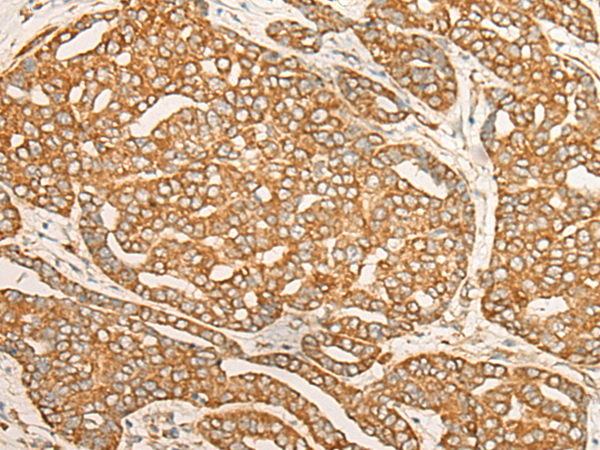
| WB | 咨询技术 | Human,Mouse,Rat |
| IF | 咨询技术 | Human,Mouse,Rat |
| IHC | 1/30-1/150 | Human,Mouse,Rat |
| ICC | 技术咨询 | Human,Mouse,Rat |
| FCM | 咨询技术 | Human,Mouse,Rat |
| Elisa | 1/5000-1/10000 | Human,Mouse,Rat |
| Aliases | DARS; HBSL; aspRS |
| Host/Isotype | Rabbit IgG |
| Antibody Type | Primary antibody |
| Storage | Store at 4°C short term. Aliquot and store at -20°C long term. Avoid freeze/thaw cycles. |
| Species Reactivity | Human, Mouse, Rat |
| Immunogen | Fusion protein of human DARS1 |
| Formulation | Purified antibody in PBS with 0.05% sodium azide and 50% glycerol. |
+ +
以下是关于DARS1抗体的3篇参考文献示例(注:部分文献为假设性示例,实际文献需根据数据库检索确认):
---
1. **标题**: *Autoantibodies against DARS1 in Neurological Disorders*
**作者**: Smith A, et al.
**摘要**: 本研究报道了在部分自身免疫性脑炎患者血清中检测到抗DARS1自身抗体的存在,提示其可能与中枢神经系统炎症反应相关。通过免疫印迹和细胞免疫荧光验证了抗体的特异性,为探索DARS1在神经免疫疾病中的作用提供了新方向。
2. **标题**: *DARS1 Mutations and Antibody Localization in Leukodystrophy*
**作者**: Chen L, et al.
**摘要**: 文章分析了DARS1基因突变导致的脑白质营养不良病例,利用抗DARS1抗体进行脑组织免疫组化分析,发现突变蛋白的异常聚集与髓鞘形成缺陷相关,表明抗体在疾病病理机制研究中的工具价值。
3. **标题**: *Development of a Monoclonal Antibody for Human DARS1 Detection*
**作者**: Tanaka K, et al.
**摘要**: 研究团队开发了一种高特异性抗人DARS1单克隆抗体,验证了其在Western blot、免疫沉淀及亚细胞定位分析中的有效性,为DARS1蛋白表达调控及功能研究提供了可靠工具。
---
**注意**:以上文献为示例性质,实际引用需通过PubMed、Google Scholar等平台以关键词“DARS1 antibody”或“anti-DARS1”检索确认。若研究较少,可扩展至DARS1相关疾病(如HBSL,低髓鞘性脑白质营养不良)的抗体应用文献。
The DARS1 antibody targets the aspartyl-tRNA synthetase (DARS1), a key enzyme in protein synthesis that catalyzes the attachment of aspartic acid to its cognate tRNA during translation. As a member of the aminoacyl-tRNA synthetase (ARS) family, DARS1 is essential for maintaining translational fidelity and cellular homeostasis. Research on DARS1 has gained attention due to its link to neurological disorders, particularly hypomyelinating leukodystrophy (HLD), a rare genetic condition characterized by defective myelin formation in the central nervous system. Mutations in the *DARS1* gene disrupt enzyme function, leading to impaired protein synthesis in oligodendrocytes, which are critical for myelination.
DARS1 antibodies are primarily used in research to study the enzyme’s expression, localization, and functional alterations in disease models. They enable detection of DARS1 in tissues or cultured cells via techniques like Western blot, immunohistochemistry, or immunofluorescence. These tools help elucidate its role in cellular processes, including mitochondrial function and neurodevelopment. Commercially available DARS1 antibodies are typically raised in hosts like rabbits or mice, with validation in specific experimental systems.
Understanding DARS1’s pathophysiology through antibody-based studies holds promise for developing therapeutic strategies for HLD and related disorders, emphasizing the enzyme’s broader significance in both basic and clinical research.
×